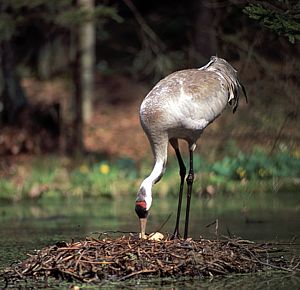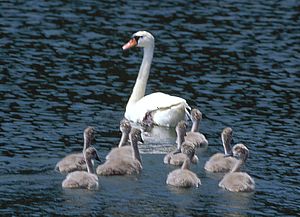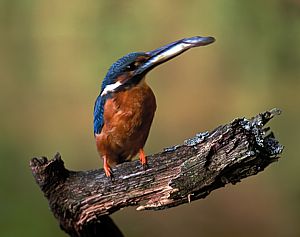|
BIRDS
|
||||||||||||||
Text:
|
General information
The fauna of birds of Wigry National Park is not well-known yet. By the year 2002 205 species of birds were classified which constitutes for almost 50 % of the fauna of birds in Poland. Comparatively the best recognized fauna is the fauna of birds of Wigry lake. The fauna mainly includes the water-mud birds e.g.: reed warbler (about 550 pairs), black-headed gull (about 300 pairs), great crested grebe (about 270 pairs), coot (about 240 pairs), great reed warbler (about 156 pairs). It is worth paying attention to the group of 17 species of predacious birds living in the area of Wigry National Park, including: buzzard, hobby, sparrow-hawk and our greatest bird of prey - white-tailed eagle.
191 species of birds, classified and recorded by the Park, are subject to a specific protection. There are many rare species listed in "The Red book of Polish animals" and "The red list of animals in danger of extinction" The red book included 34 species, two of them: black-throated loon- Gavia arctica and European golden plover Pluvialis apricaria, were classified to the category of decaying or probably decaying animals in our country. These data is outnumbered by lower risk species, but close to the extinction (8 species) and the species not showing the population regress for the time being (8 species). There are (6) species of very high risk of extinction, (5) species of high risk of extinction and 6 species in danger of extreme extinction.
The red list of animals included 31 sorts of birds living in the area of the Park. 10 species are rare in Poland, 9 species are in danger of extinction and 7 species are in a danger of extreme extinction.
The biggest birds of the Park are cranes and swans.
Crane Grus grus is a bird whose length of the body varies from 130 to 140 cm, the spread of wings is 240 cm and the weight of body reaches 4-7 kg. It has a long neck, a beak of average length and long stilts-like legs. Cranes never sit down on the trees, as they are used to living over ground - they tread slowly; if necessary they run. The voices produced by cranes, called "clangor" take their power from the special trachea construction of these of birds. Cranes build their nests on the ground among swamps, peat bogs and on the miry edges of lakes; sometimes they settle wet, thinned out alder stands. The nest has about 1 m in diameter and it is made from sticks and reeds. The breeding season begins at the beginning of April when the female lays 2 elongated green and grey eggs which are then incubated by both parents. As soon as the nestlings are hatched they are able to abandon their nest. Cranes eat insects, small vertebrates, leaves of grass, herbs and seeds of plants. They fly to Poland in March and fly away in September and October. They spend the winter period in central Africa.
Mute swan Cygnus olor is a bird whose body length can vary from 150 to 170 cm, the spreads of wings reaches 220-240 cm and they can weigh from 8 to 12, 5 kg. There is a characteristic black, bruise-like growth on the beak which is more visible at the male. Swan eat mostly water vegetation (green velocities of water plants, seeds and grass) and in smaller quantities of such animals as snails, molluscs, leeches, larva or insects. Swans spend most of their life afloat. Their nests can be found in inaccessible places such as shallow water, among reeds or sometimes on small islets.
In April - May the female lays 5-9 eggs which are incubated by her for 35 days. The male's role at this time is to defend and to keep the intruders off the nest. Swans get in pairs for a lifetime. During the first year of life the nestlings are covered with grey and brown feathers which later on turn white Phot.3. Mute swan flies to us in March - April and flies away starting from September till December. It spends the winter period on the Baltic Sea. In the recent years it happens that swans do not fly away but stay in large groups round the unfrozen fragments of lakes.
One of the smaller aquatic birds of the Park is the kingfisher.
Kingfisher Alcedo atthis is the only representative of subgroup of kingfishers in Poland. Its body is about 17 cm long, the spread of wings is 27 cm, the weight of body reaches 35-40 g. It lives in the vicinity of slowly flowing streams, rivers and channels of steep banks and slopes grown with trees or with shrubs and branches hanging over water. It willingly sits on them looking for food in water. It mainly eats small fishes (bleaks). Having noticed the victim the kingfisher quilts vehemently grabbing it under water and then sits down on the branch, deafens and swallows it. It also hunts for water insects e.g. larva's of water beetle the swimmer. The nest is built in a burrow, located in most cases on the steep wall of a slope. It takes about 3 weeks for a kingfisher to dig the burrow (its corridor is about 1 m long). At the end of the corridor there is a breeding chamber stuffed with fragments of fish-bones, hulls and fragments of insects. The kingfisher has one or two breeding season every year (April-June and June-July) laying 5-8 white eggs altogether. At first nestlings are completely naked but after several days their bodies become hairy and feather-like what resembles small hulls. The young are fed by both parents. Kingfisher is a territorial bird - it defends its hunting districts and keeps the individuals of the same sort away. It gets in pairs only for the breeding season. In autumn it bivouacs at ponds and lakes and it spends the winter period in the vicinity of unfreezing water reservoirs.
One of the most commonly met predacious birds in the Park is the Eurasian hobby Falco subbuteo.
Hobby Falco subbuteo is the representative of falcon-like family. Its body is about 34 cm long, the spread of wings is about 80 cm, the weight of body varies from 190 to 300g (the female is a little bit bigger greater than the male). The beak construction (the upper part of the beak is bent like a sharp bow and finished with a prominent hook) makes quick and efficient plucking of the trophy possible. It is a perfect aviator; thanks to the long, sharply finished wings it can reach large speeds of flight. When it comes to aerial hunting for other birds it uses the wide chest and claws. In Poland it lives on lowlands and in the vicinity of greater forest complexes. In most cases it lives on the edges of forests. Hobby hunts for swallows, larks and other little birds and insects (mainly greater cockchafers and dragon-flies). It does not build nests, but it uses the nests of other birds, e.g. crows, rooks and smaller birds of prey. At the beginning of June the female lays 3-4 spotted eggs which are then incubated by both parents. The nestlings obtain the ability of flight after 25 days. Hobby is a wandering species. It flies to Poland in April and May and starts to fly away from August till October. It spends the winter period in Africa.
|
|||||||||||||
|
|
|




